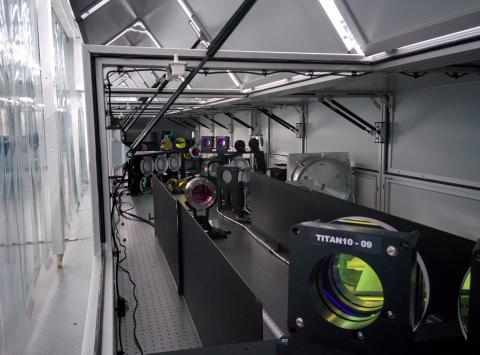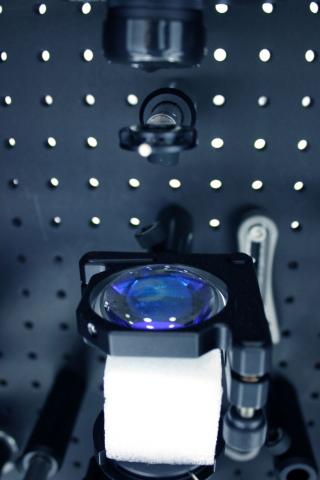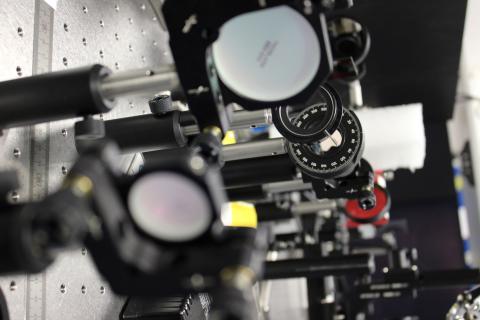



General information
-
Hosting OrganisationConsorcio Centro de Láseres Pulsados
-
AddressEdificio M5. C/ Adaja, 8. Parque Científico de la Universidad de Salamanca. 37185 Villamayor. Salamanca
-
Contact Info:
-
Phone
-
Emaildirector@clpu.es
Description
The Spanish Center for Pulsed Lasers (CLPU) was born to be the Spanish facility at the forefront in the field of ultra-intense ultra-short pulsed lasers, which could meet the demand of the scientific, technological and industrial community to develop frontier research and projects, through a policy of competitive open access.
It was established in December 2007 as a Consortium composed of the Ministry of Science, Innovation and Universities (former Ministry of Science and Education), the Regional Government of Castilla y León, and the University of Salamanca. It belongs since then to the "Spanish Roadmap for Unique Research and Technology (https://www.ciencia.gob.es/en/) (ICTS by its Spanish initials) and right now it is part of the General State Administration. Its uniqueness is given by VEGA, a high-repetition-rate (HRR) Petawatt-Class (PWC) laser system. VEGA is the most powerful laser system in Spain and it is one of the three HRR-PWC system operating in the world. The advent of the PWC lasers has revolutionized the physics of particle accelerations. Compared to conventional accelerator, lasers can produce ultra-short particle beams with high brilliance, low emittance and broad energy spectrum.
The in-house scientific expertise guarantees a cutting-edge top-quality service, working side by side with users from all over the world, while also pursuing its own experimental challenges.
Main equipment or Facilities
From the very beginning, CLPU has looked for a versatile identity to accommodate more users, more experiments and more technological, scientific and innovative developments without compromising quality. This is why CLPU is equipped with a unique laser system named VEGA, embracing three synchronized femtosecond Titanium-Sapphire (Ti:Sa) lasers: VEGA-1 (20 TW), VEGA-2 (200 TW), and VEGA-3 (1 PW). In addition to its high power and the ability to deliver very short pulses of around 25-30 femtoseconds at a high repetition rate (1 Hz at the PW output and 10 Hz at the TW outputs), VEGA laser system at CLPU also offers a high temporal contrast.
Additionally, a CPA Titanium Sapphire laser system has been integrated into the VEGA laboratory. This system is able to provide at 1 kHz repetition rate, 2 mJ, 20 fs pulses or 0.6 mJ 6 fs pulses after a post-compression setup with CEP (Carrier EnvelopePhase) stabilization control.
Projects under Development
CLPU encloses a research center and a unique scientific and technical infrastructure which are in the the cutting-edge of knowledge and technology through the development of projects from the European, Spanish and regional calls.
The projects promote actions falling into the strategic lines of CLPU and those that are aligned with the Spanish National Plan for Scientific and Technical Research and Innovation proposed by the Ministry of Science, Innovation, and Universities and the guidelines set by the Horizon Europe Program, among others. Thus, for example, CLPU is a partner in the EU-funded RADNEXT project, led by CERN, which aims to create a network of facilities and related irradiation methodology for responding to the emerging needs of electronics components and system irradiation. This community brings together a collection of facilities and skills to address worldwide user needs for space and high-reliability ground-level applications, including automotive, defence, medical, and high-energy physics accelerators.
In summary, right now, the CLPU is involved in seven European projects and eight national projects, one of them to boost the capabilities of the ICTS, by building a new experimental area (AREX2).
Please visit our webpage to see more about our projects:
https://www.clpu.es/en/proyectos-infraestructura/
https://www.clpu.es/en/proyectos-investigacion/
https://www.clpu.es/en/proyectos-innovacion/
Technology Capabilities
The Spanish Center for Pulsed Lasers is a unique scientific and technical infrastructure thanks to VEGA, the only laser system in Spain capable to reach one petawatt of peak power. A laser system with singular architecture, as it has three synchronized outputs of different powers that offer services to scientific, and industry users worldwide. The entire VEGA system is currently installed, operating, and open to competitive and non-competitive access. A complementary ultrashort laser system with Carrier Envelope Phase (CEP) stabilization control has been assembled. The CLPU is also equipped with a large ensemble of detectors for primary and secondary beams. beams (electron, proton, neutron…).
One advantage of the newly emerging laser acceleration is its unique ability to reach extremely high energies that are far beyond in any other conventional methods. Another advantage is the possibility of producing rather compact machines, at least when compared to very big synchrotron.
The CLPU also host a CPA Ti:Sa laser system operating at 1 Hz repetition rate with a pulse energy up to 7 mJ and 120 femtoseconds of temporal pulse duration offered by the Ultrashort Laser Applications and Micromaterial Processing (ULAMP) Service. Currently, ULAMP service is being upgraded with new laser systems and optical equipment through the DOLEV infrastructure improvement project. It also has an electronic microscopy and analysis tools, mechanical, electronic, magnetic elements workshop, laser micro machining, and targetry station, calibration sources, etc. To design, maintain, and operate these cutting-edge technologies, the infrastructure contributes to the development of new innovative technologies related to lasers as vacuum systems, beam transport equipment, high-powerful electronic devices, radioprotection, targetry design and diagnostics.
Summary of Research Services
The CLPU offers these main services to users:
* VEGA, the HRR-PWC laser system; through competitive and non-competitive access researchers and companies can get access to a cutting-edge technology, an innovative experience and highspecialized knowledge. It has multiple purposes in several fields as Medicine (Flash protontherapy), Fusion, Plasma Physics, Material Science, etc.
*Innovation Laboratories:
- Ultrashort Laser Applications and Micromaterial Processing (ULAMP) Service, offers other HRR laser system which beam can be divided to service multiple workstations for microprocessing of materials, micromachining, laser cleaning, laser texturing of surfaces, laser filamentation, and X-ray generation:
https://www.clpu.es/en/ulamp-technical-features/
- Laboratory of Innovation And technology Lasers (LITeL), also hosts a continuous wave (CW) laser at 532 nm approx. as a multipurpose pumping system of Ti:Sapphire lasers (CW and/or locking) and additionally, several diode lasers (800, 940 and 980 nm) to pump laser crystals in different resonant cavities. The main objective of this lab is to provide service to industrial and scientific users who require the development of laser oscillator technology both for the development of new designs, the improvements of commercial systems and/or diagnostics techniques for laser beams on those systems:
https://www.clpu.es/en/litel-technical-features/
- Microscopy Service, which has a Scanning Electron Microscope (SEM), which offers a resolution below 5 nm with magnifications of up to one million times, and quantitative and qualitative equipment like EDX and EBSD detectors for elements and compounds:
https://www.clpu.es/en/microscopy-features/
- Mechatronic Laboratory, which is a fusion of mechanical and electronic workshops. It has been created to serve the laser users at CLPU as well as the companies based in the Scientific Park of the University of Salamanca and abroad. It is equipped with a jig saw, a vertical drilling machine, a
Procurement process
In accordance with the Spanish Law 9/2017, of 8 November 2017, on Public Procurement, which transposes Directives 2014/23/ EU and 2014/24/EU of the European Parliament and of the Council, of 26 February 2014.
Detailed information can be found at https://www.clpu.es/en/contractor-profile/